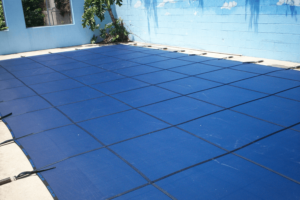It’s time to winterize your swimming pool, protecting it over the colder winter months. When the temperatures drop, water starts to freeze, and if not properly planned for, that can mean a big repair bill next swim season. Even in areas of the country where the water isn’t as likely to freeze, the water can be cold enough to make swimming uncomfortable, making it necessary to close the pool for the winter months. Knowing how to properly close and protect your pool is part of responsible pool ownership and helps you protect your investment and your family.
The Dangers Of Skipping Winterization
Everyone knows what happens when your pipes freeze in the winter. The pipe bursts, floods the house, and the repairs to the plumbing, replacing the flooring, and managing mold remediation can quickly skyrocket. Your pool operates using a delicate chemical balance and water circulated through pipes and machinery to provide an oasis from the summer heat, but these parts were not meant for freezing temperatures or long terms of non-use, which is why winterizing your swimming pool is so important.
Freezing temperatures can more easily damage the equipment that maintains a non-winterized swimming pool, bursting pipes and causing machinery to seize up. They can damage liners, destroy your pool’s chemical balance, and cause brittle or fragile equipment to break down. A pool that is not closed properly in warmer temperatures risks staining, scaling, algae growth, and stagnation. Whatever your weather conditions, you need to know how to properly winterize your swimming pool for your area’s climate.
Start Clean
The first step to close your pool for the winter is to get it as clean as possible first. This includes skimming for surface debris, using a pool vacuum to get all silt and sand from the bottom, and making sure the physical structures of the pool have been appropriately washed and rinsed. A thorough cleaning doesn’t just give you a cleaner pool to close down, it makes it easier to balance your chemicals and prevent bacteria and algae proliferation while the pool is hidden away under a winter safety pool cover.
Clear Your Pool Area
Remove the ladders, boards, baskets, and anything else that won’t be staying in your pool over the winter months. It’s easier to winterize your pool if you get everything out of the way so you can cover it up to prevent dust or debris from re-entering the water.
Balance Your Water Chemistry
Some pool retailers and pool service companies sell kits that make closing your pool for the winter months easier by providing all the chemicals you need, ready to go. Otherwise, you’ll need to use a test kit and manually adjust your pool’s alkalinity, pH, and hardness, just as you do to keep your pool water safe on a regular basis. Starting with Alkalinity first, balance your pool to 80-150 ppm, then a pH of 7.2 to 7.6, and finally a calcium hardness of 200-400 ppm. It’s ok to run on the higher side of these levels, as over time, they will drop.
Give It A Good Shock
Shocking the water prevents bacterial growth. Since you just balanced your chlorine levels, you’ll want to use a good non-chlorine shock, then run the system for several hours to circulate it through your pool’s water thoroughly. You’ll then want to add some non-staining algaecide to control algae growth, following package instructions and letting it circulate through the water as well.
Partially Drain Your Pool
In order to winterize your pool, you need to get the water out of the skimmer and return lines. Drain it until the water line is several inches below these fixtures and use a blower to remove water from the lines. The drain plugs on your equipment can now be opened to remove water in the system. Remove your chlorine pump, any removable hoses, and the pump. Once drained, these can be stored inside over the winter. Expanding drain plugs can be used to plug pool lines, and you can add pool antifreeze to them for extra peace of mind if you’re in a particularly cold area.
Keep It Covered
Close your pool for the winter by securing your cover to the pool and making sure it has tight straps and springs that keep the material taut and the cover from sagging. Our winter safety covers are custom fit to your pool, giving you a nice, tight appearance that helps prevent accidental drowning injuries, even when the temperatures drop and you aren’t expecting anyone to try to access your pool. These insulated covers are anchored around the pool’s edge and made of a durable mesh that is resistant to UV and Chlorine damage, doesn’t mildew, and provides a surface that can be walked on, if needed, to remove debris or save a person or pet who otherwise would have entered the water.
Start Your Pool Winterization For Free
The cost to winterize your pool with a winter safety cover that helps protect not just your pool but your family, friends, and pets is more reasonable than many pool owners imagine. Contact your local installer to schedule a visit. They’ll inspect your pool area, take measurements, and give you a free estimate that lets you make an informed decision about the safest way to close your pool for the winter. Create a safer pool area this winter with the help of your local All-Safe Pool professional today.






